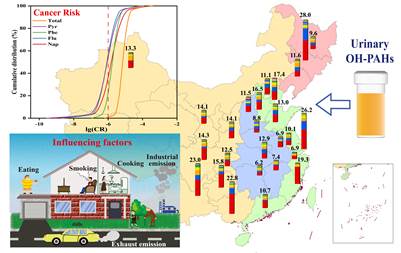近日,广东工业大学环境健康与污染控制研究院余应新教授课题组题为《Urinary monohydroxylated polycyclic aromatic hydrocarbons in the general population from 26 provincial capital cities in China: Levels, influencing factors, and health risks》的研究性论文在Environment International (EI, https://doi.org/10.1016/j.envint.2021.107074)上发表。论文第一作者为博士研究生黄森源和医师李琴,通讯作者为余应新教授。该论文报道了中国26个省会城市普通人群(N = 1154)晨尿中12种单羟基多环芳烃(2-羟基萘(2-OH-Nap)、1-羟基萘(1-OH-Nap)、3-羟基芴(3-OH-Flu)、2-羟基芴(2-OH-Flu)、1-羟基芘(1-OH-Pyr)、3-羟基菲(3-OH-Phe)、2-羟基菲(2-OH-Phe)、1-羟基菲(1-OH-Phe)、9-羟基菲(9-OH- Phe)、4-羟基菲(4-OH-Phe)、6-羟基䓛(6-OH-Chr)和3-羟基苯并[a]芘(3-OH-BaP))的浓度水平及区域分布,并分析评估了PAHs暴露的可能来源、影响因素及健康风险。本研究首次对中国普通人群PAHs内暴露开展了全国性的初步研究,为更好地了解发展中国家人类PAHs暴露及相关的人类健康问题提供科学信息。

多环芳烃(PAHs)是有机物不完全燃烧的产物。人体可通过呼吸吸入、皮肤吸收和饮食摄入等途径暴露于PAHs。PAHs进入人体后,经过I相和II相代谢反应形成羟基化代谢物(OH-PAHs),并以葡萄糖醛酸结合物或(和)硫酸结合物随尿液排出。因此,尿液OH-PAHs,被广泛用作PAHs暴露评估的生物标志物。目前只有德国、加拿大、美国、韩国等少数发达国家已经进行了大规模普通人群监测,缺乏发展中国家大规模人群的PAHs监测数据。中国作为一个快速发展的发展中国家,由于经济的快速发展和工业化程度的提高,环境污染问题比较严峻。本研究收集的中国26个省会城市共1154个普通人群晨尿样本中,Σ12OH-PAHs的浓度范围为1.39至228 μg/L,中值浓度为13.1 μg/L。OH-Nap是主要检出的化合物,占总OH-PAHs的65.1%。而对于致癌物BaP和Chr,它们的单羟基代谢物的检出率低于50%,中值浓度均低于其LOD。位于上海、昆明、南宁、长春的城市居民,PAHs内暴露水平要高于其它城市,这可能与样品采集时间、居民生活习惯、地区间经济发展和能源消耗的差异有关。此外尿液中OH-PAH浓度水平与吸烟、体重指数(BMI)、性别、年龄等多种因素有关,其中吸烟是主要的影响因素。PAH s暴露在男性、超重人群、吸烟者及18-59岁的成年人中更为普遍。呼吸吸入和饮食摄入可能是普通人群暴露于PAHs的主要途径。蒙特卡罗模拟结果结表明,有0.8%的中国居民暴露于PAHs具有潜在的非致癌风险;有99.2%的CR值超过了可接受水平(10-6),Nap和Phe是主要的风险来源。本研究表明,中国普通人群普遍暴露受到PAHs暴露,并存在潜在的致癌风险。
论文的网址:https://doi.org/10.1016/j.envint.2021.107074
图文摘要:

英文摘要:
Polycyclic aromatic hydrocarbons (PAHs) derived from the incomplete combustion of organic materials are associated with adverse health effects. However, little is known about PAH exposure levels and their influencing factors on a large scale in developing countries. In this study, urinary monohydroxylated metabolites of PAHs (OH-PAHs), including the metabolites of naphthalene, fluorene, phenanthrene, pyrene, chrysene, and benzo[a]pyrene, were measured in 1154 samples in the general population nationwide from 26 provincial capitals in China. Concentrations of OH-PAHs ranged from 1.39 to 228 μg/L. OH-Nap, metabolite of naphthalene, was the predominant compound, accounting for 65.1% of totals. People in eastern, southwest, and northeast China, such as Shanghai, Kunming, Nanning, and Changchun, suffered more PAH exposure than other regions which might associate with sampling time, living habits of the subjects, and the imbalance of economic development and energy consumption across regions. Urinary OH-PAH concentrations were associated with body mass index, gender, and age, and smoking was the main correlating factor. Inhalation and diet might be the main exposure route of human exposure to PAHs, especially for smokers by inhalation. Hazard indices showed that no subject was exposed to PAHs with potential non-carcinogenic risk. Furthermore, the carcinogenic risk was the most significant health effects, with almost all subjects having carcinogenic risk values higher than the acceptable level of 10−6. Naphthalene and phenanthrene were the main contributors. The results also suggested a possible relationship between PAH exposure and lung cancer in the Chinese population. This first nationwide study on human internal exposure to PAHs provides a large body of scientific information for governmental decision-making about associated human health and the prevention of human exposure to PAHs.
项目资助:本研究得到国家自然科学基金(41991311,41977303)、粤港澳污染物暴露与健康联合实验室(2020B1212030008)和广东工业大学百人计划项目的支持。